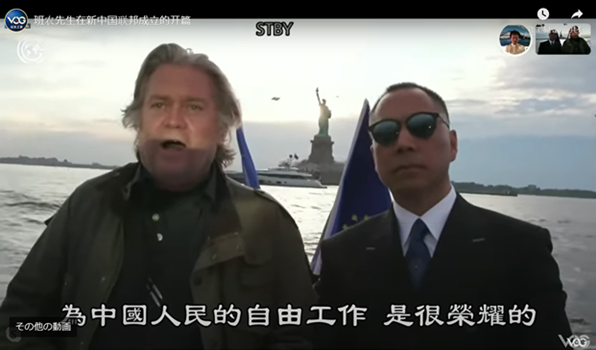On June 4, 2020, Xi Jinping stifled mourning and commemorations for victims of the 1989 Tiananmen Square events and refused to reassess the incident, reiterating the Communist Party of China (CPC)’s official stance. In this context, one day prior in New York City, a ceremony declaring the New Federal State of China was broadcast on YouTube for the whole world to see and hear about the idea of a Chinese Federation. Experts from 90 countries joined in expressing their opinions.
A surprise guest also commented at the ceremony: former White House chief strategist Steve Bannon. The man with sunglasses standing next to him is Guo Wengui, a businessman who has defected from China to the United States.
In his speech, Bannon said his pride of showing his new vision of a federal state for China to the public and affirmed his intention to contribute to the overthrowing of the CPC. Bannon served as chief strategist in the Trump administration but later resigned. He is a founding member and former Executive Chairman of Breitbart, a right-wing media outlet, and has consistently made the radical claim that the United States are at risk of becoming a vassal state of China.
Guo Wengui, on the other hand, is a businessman from China’s Shandong province who never went to high school and witnessed the 1989 Tiananmen Square massacre. In 1992, he was arrested and imprisoned for providing funds and goods to the demonstrators. After his release from prison, he was appointed as the chairman of Henan Grand Old Board Furniture Factory. He later became the owner of a real estate company and was involved in the development of a park for the Beijing Olympics.
Guo has an extensive network of contacts. But while developing this project, Beijing’s Vice-Mayor Liu Zhihua lost his position (the mayor of Beijing at the time was State Vice-President Wang Qishan). In December 2013, upon being called for questioning by the Central Commission for Discipline Inspection in connection with the suspected bribing of a former deputy director of the Ministry of State Security, Guo escaped via Hong Kong and is now living in the US.
The idea of a Chinese Federation is not new
In China, there is an ancient concept of Great Unity. The word great here is a verb meaning to give importance to and to respect, and unity means to make the lords and ladies of the world respectable. It is therefore to be understood as the unification of the Heavenly Children. In China, this grand unification ideology is dominant, and the idea of decentralization and federalism, even if not prevalent today, has long been discussed as a way to achieve this unity. A declaration adopted at the Second Congress of the Communist Party of China in July 1922 states that the idea of a certain degree of federalism had been proposed, with the following two points:
– overall, Chinese provinces (referring to all provinces, except those with ethnic minorities) would be ruled under a centralized system ;
– but Inner Mongolia, Tibet, and Xinjiang would be promoted as autonomous territories within a Federal Republic of China.
From these points of view, it is evident that the thinking of the CPC in the early days of its founding had federation in mind, effectively opening the way for the creation and maintaining of a system based on decentralization of power.
Is there a roadmap to a New Federal State of China?
Based on this, two scenarios present themselves: (1) a single state moving to federalism, or (2) divided nations uniting to form a federation.
If China were to move to a federal system today, which scenario would apply? The answer is a tricky one, as neither scenario is a perfect fit. China has many provincial capitals, each of which lacks a tradition of self-government because the country was unable (or unwilling) to establish an autonomous foundation for a federal system. Besides, China’s history has been riddled with rivalries and has not had the peaceful environment necessary to form a federation. Incidentally, Belgium is the only country that became a federal state with the second form above. The fact that the Kingdom of Belgium was able to transition to the Belgian Confederation was due to the fact that the religious and linguistic divisions were made in a peaceful environment.
In light of this, how should we view the New Federal State of China project? The following is a summary of this author’s own observations based on non-publicly available information.
- Chinese funds are supporting Mr. Bannon’s Federal China push, while elements within the Trump camp may be manufacturing one side of the current US-China clash.
- The anti-Xi Jinping faction is casting a shadow over the CPC, and regime reformers are making themselves more visible. Given the new directions given at the latest National People’s Congress, the deterioration in China-US relations around the time of the Beidaihe Conference, as well as the resistance of the free Hong Kong movement, a move to un-sit Xi Jinping may very well be seen as the best way to get out of the current deadlock.
- There is a possibility that Chinese elements are staging the current Hong Kong riots, in an effort to divide China. The question being: who is contributing the funds?
In short, the ensemble cast involved in the idea of a New Federal State of China shows the significant influence of that very idea. The following statement by the Himalaya Supervisory Organization non-government organization gives us a hint as to the next specific actions they might take:
“ The Mission of the Himalaya Supervisory Organization – At the time of the announcement of the establishment of the New Federal State of China, the Himalaya Supervisory Organization hereby solemnly pledges: in view of the fact that the CPC still holds the state power to exercise various methods of extreme control over the people, the Himalaya Supervisory Organization will make all preparations for the formation of the New Federal State of China with outreach efforts. It will actively liaise with various countries, political parties, associations and international friends supporting the establishment of the New Federal State of China and coordinate relationships with the interim government. It will guide and assist the preparation of the new government, and ensure the smooth, effective, and steady progress of the preparation of the New Federal State of China. The Himalaya Supervisory Organization will collaborate with international supervisory organizations to oversee the operations of the New Federal State of China according to law. The Himalaya Supervisory Organization complies with both international law and laws made by the New Federal State of China and accepts strict supervision from relevant international legal institutions. (Source: A Declaration of The New Federal State of China)
To organize this Himalaya Supervisory Organization for ensuring rule of law, democracy, and freedom in the new China can clearly be seen as a direct response to China’s pushing for new national security legislation in Hong Kong.
Looking at the recent developments in the United States, China, and Hong Kong, including the concept of the New Federation State of China, it appears that the idea of “Pax Japonica” championed by this author’s Institute for International Strategy and Information Analysis (IISIA) is steadily making progress…
Picture credits: VOG Media






Be First to Comment